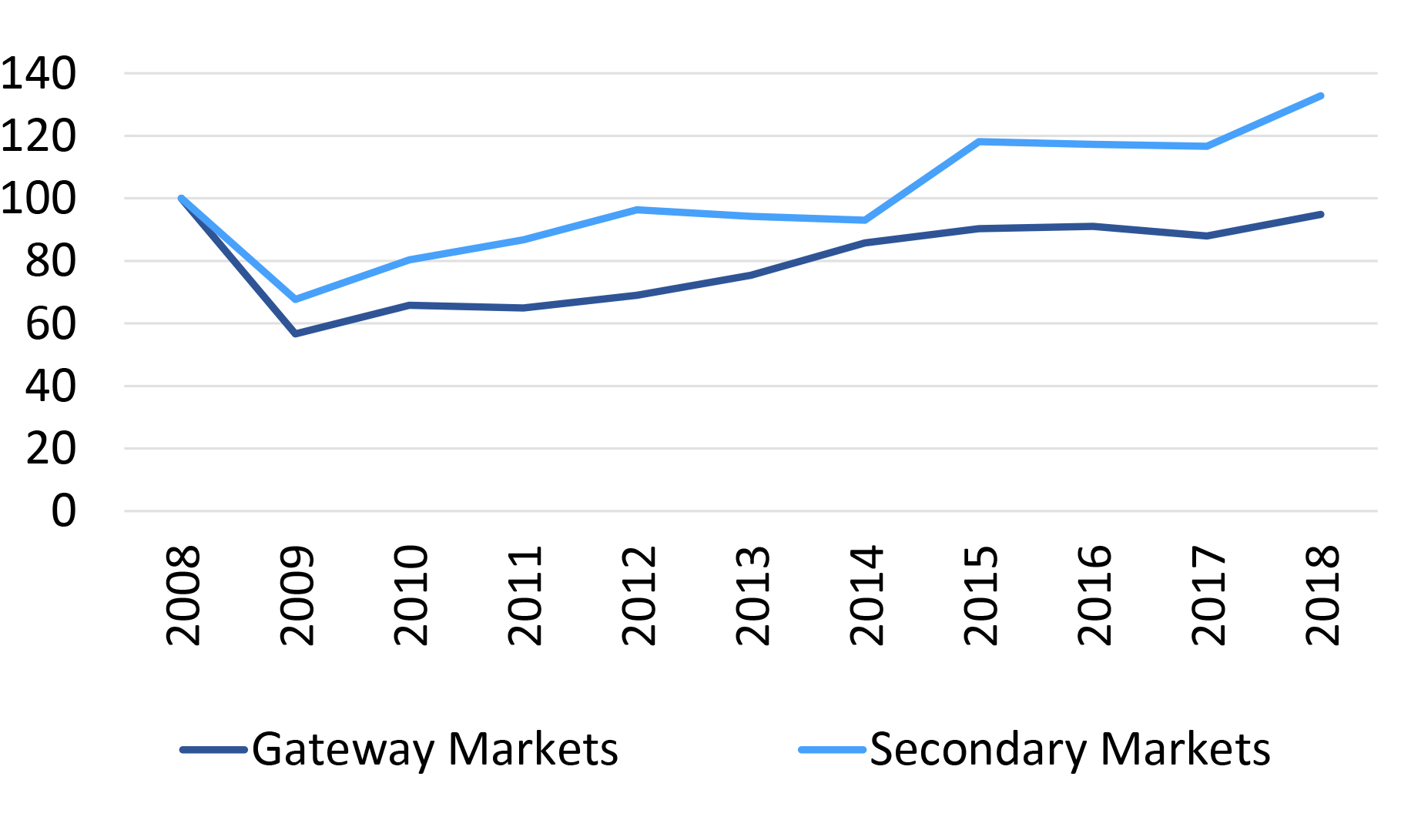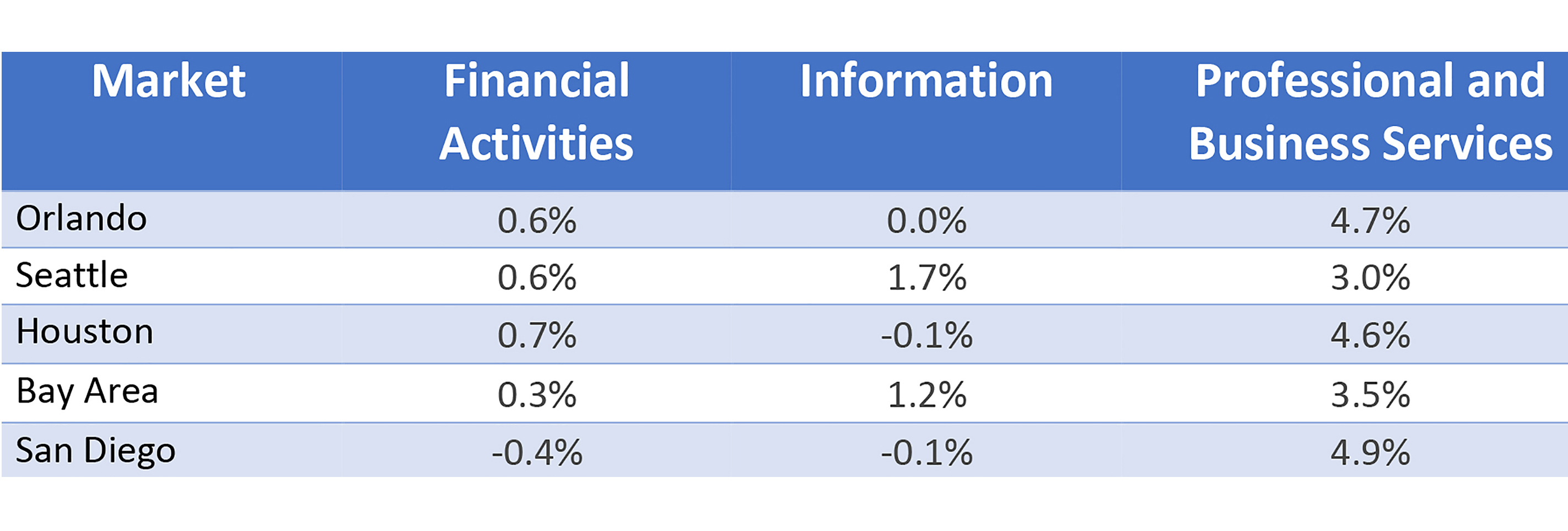Rise in Office Jobs Boosts Listed Rents, Occupancies
Expanding employment in financial services, professional services and IT is lifting asking rates and lowering vacancies, especially in some secondary markets.

Chris Nebenzahl
Office-using employment growth, specifically in the professional and business services sector continues to drive office demand. As a result, vacancy has been getting tighter and listing rates are increasing, especially in secondary markets with strong demographic fundamentals. Cap rates have been falling in many secondary markets as their office fundamentals improve, and at this point in the cycle, the gap in acquisition yields for primary and secondary markets is thin.
Orlando, Seattle, Houston and the Bay Area, each with historically unique employment bases, have emerged as the leading markets for office-using employment. Overflow from gateway markets combined with relatively low costs of living have created strong employment centers in secondary markets nationwide.
Orlando is in the midst of a late-stage growth cycle, as an accelerating tech industry, relative tax friendliness, baby boomer retirement and in-migration from Puerto Rico have combined to create a significant tailwind for the commercial real estate market. Professional and business services employment grew 4.7 percent as of November 2018. Corporate relocations and expansions of large tech companies, grocery chains and hospitality companies have driven high-end job growth in central Florida. Office construction remains modest, yet developers are watching the migration and employment growth trends closely, and projects in the planning and under construction phases account for more than 15 percent of total stock.
High demand for office space in Seattle has led to very strong fundamentals in the Emerald City. Technology, software and intellectual property have underpinned most of the economic growth this cycle and, as a result, Seattle has emerged as a key commercial real estate market. Heavy job growth in the information and professional and business services sector, led by Amazon, Apple, Google and Facebook, has also increased development in the urban core. Most of the new office buildings have been completely pre-leased by the tech giants. While employment growth may be slowing somewhat over the past two years, job growth remains well above the national average, and will likely continue to support new office product. Vacancy currently sits below 10 percent.
Despite a vacancy rate almost double that of neighboring San Francisco, the Bay Area saw office listing rates increase 2.3 percent in the three months ending in December, according to Yardi Matrix. The Bay Area, which includes Silicon Valley, as well as Oakland, had the second strongest three-month rent growth among top markets. Just down the coast in San Diego, office listing rates accelerated 2.1 percent as professional and business services employment increased 4.9 percent year over year. With significant regulatory barriers to development, and continued strong job growth, expect property valuations and cap rates in secondary California markets to begin mimicking the trends of their gateway market neighbors.
Houston’s office-using employment has recovered nicely after a few years of unsteady growth in the wake of oil price declines in 2014 and 2015. Professional and business services employment is up 4.7 percent in the past year ending November 2018, earning them third place among top markets. Long known as an oil town, Houston has been diversifying its economy in recent years, and employers are moving into new, state of the art office buildings in an attempt to attract top quality talent. Houston office development has been high throughout the cycle, and its vacancy rate currently sits at 22.4 percent. Developers have pulled back significantly and current construction sits at just 1.5 percent of existing stock. Continued office-using job growth has pushed listing rates up 0.6 percent in the past three months, and with additional employment gains, the office fundamentals will likely improve across the metro.
While major gateway markets continue to add jobs in office-using sectors, their rates of growth are significantly lower than many secondary markets. Chicago (0.6 percent), New York (1.0 percent), Washington D.C. (2.0 percent) and Los Angeles (1.9 percent) trail the top markets in the Southern and Western regions of the country. Companies are expanding their operations in secondary markets and taking advantage of educated workforces that have settled outside major cities.
Office Assets: Indexed Values Per Square Foot 2008-2018

Source: Yardi Matrix
As a result, office values in once overlooked markets have outperformed gateway markets throughout the current cycle. With ample capital available, and strong fundamental performance, investors will continue to focus on secondary markets to find yield and price appreciation towards the end of the cycle.
Chris Nebenzahl is associate director of research with Yardi Matrix.







You must be logged in to post a comment.